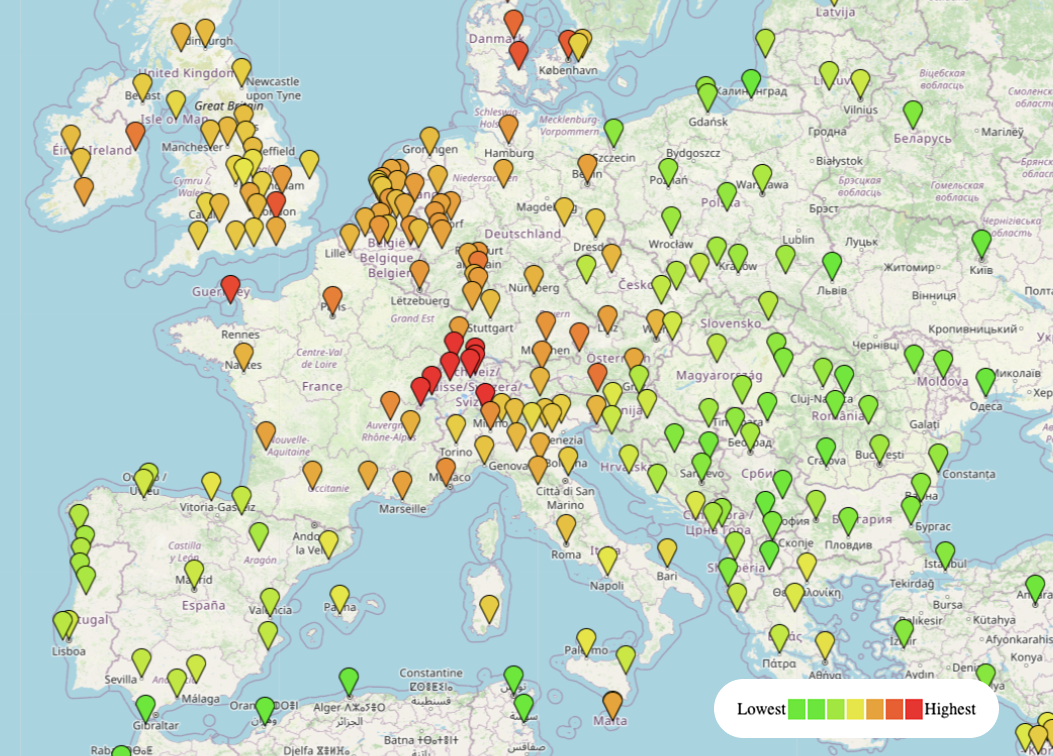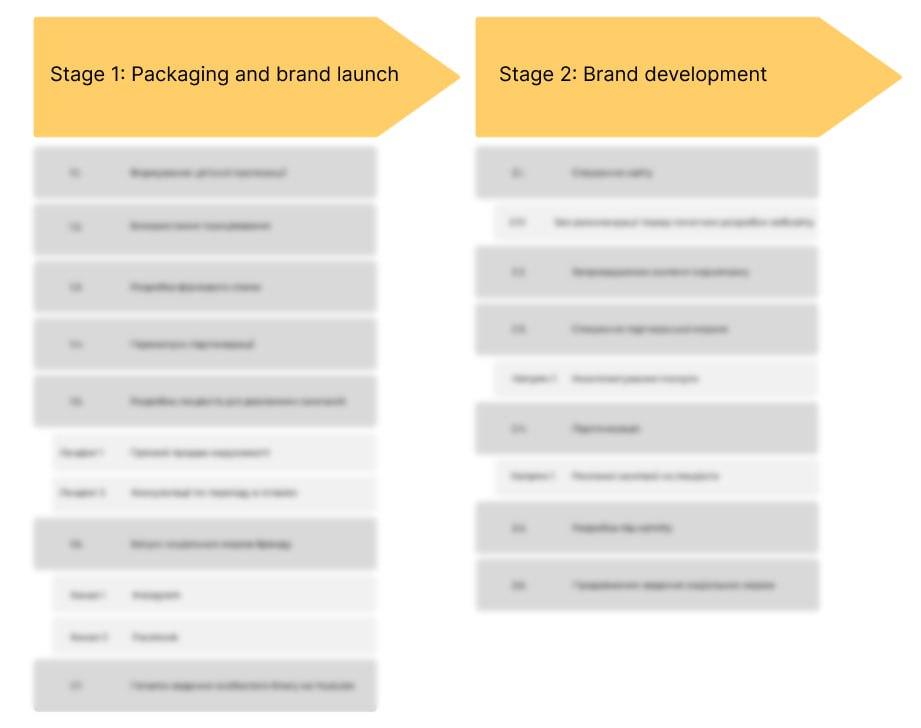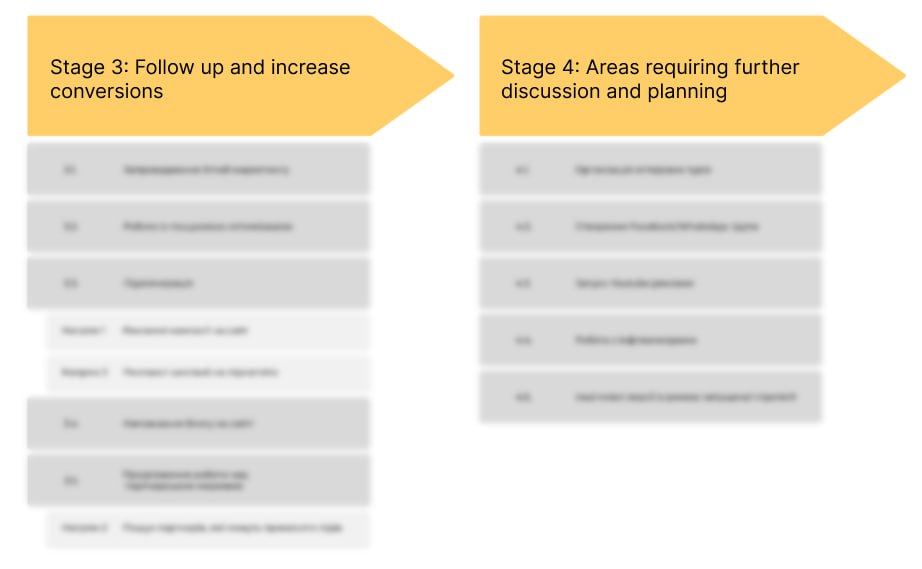Imagine you’re a Canadian who has spent a lifetime working, building a career, and creating comfort for your family. But over time, you begin to wonder: Do I really want to spend my retirement in the same city — with grey winters, high prices, and a routine that leaves no room for enjoying life?
Then, a real estate agency appears on the horizon, located in southern Spain — helping people make their dream of living in a sunny country a reality.
How do you convince potential clients that changing countries isn’t a risk — but a chance for a better life?
That’s the challenge the agency founders brought to us. Their request was clear:
💡 “We want to understand our audience, assess demand for our services, and have a clear marketing strategy to confidently enter the market and consistently close 2–3 deals per month.”
We accepted the challenge and began with in-depth research of the market, the audience, and the competitive landscape.
We signed an NDA with this client, so they will remain anonymous.
| How long did it take to develop the strategy? | 120 hours, 4 working weeks |
| What is the composition of the marketing strategy development team? | Head of Marketing Team, Head of Content Team, project manager, operational marketer, marketing assistant, content marketer, Head of PPC Department, PPC Facebook specialist. |
| How were the results of the work used? | Independent implementation by the client’s specialists. |
Is life in Spain really better? Numbers and facts
When people dream of retiring abroad, they often imagine sunny beaches, a relaxed pace of life, and low living costs. But how realistic are those dreams? Our goal was not just to confirm this perception — but to provide numbers that would dispel any doubts.
Spain: market analysis
Spain closed 2022 with a 5.5% GDP growth — one of the highest in Europe. That’s a good sign, although 2023 was expected to be less dynamic. The European Commission forecasted growth of only 1.4%. At the same time, inflation dropped to 3.3%, the lowest level since 2021
This created a two-sided situation for the real estate market:
- High interest rates slowed down mortgage lending.
- However, 45% of buyers on the Costa del Sol purchased real estate without loans.
This meant that the premium segment remained active and market demand stayed stable.
Our analytics revealed an interesting trend: although the number of transactions in 2023 decreased by 14.4% compared to 2022, demand on the Costa del Sol coastline remained strong.
On average, more than 108 properties were sold there every day.
One of the key factors in deciding to move is the cost of living in a given region. So we analyzed areas that might be of interest to the target audience — namely: North, Central, and Latin America, as well as Europe.
After researching the market, we concluded that Spain is generally cheaper than most European countries. The only regions where the cost of living is slightly lower are in Central America.

But the main question is whether moving to Spain is really beneficial for Canadians.
Spain VS Canada
- We conducted a detailed cost-of-living comparison between two cities — Málaga (the main city of Costa del Sol) and Toronto (a major Canadian city, though not the most expensive one).
The results were striking: expenses in Málaga are 41.2% lower than in Toronto:
✅ Housing rent is 50% cheaper.
✅ Groceries are 30% cheaper.
This means that to live in Málaga at the same level as in Toronto, you need nearly half the money:
$4 759 vs. $8 100
- Numbeo indexes also showed that the quality of life in Málaga is higher than in Toronto — with better ecology, higher safety, and lower crime rates.
- Toronto had an edge in healthcare quality, but most expats in Spain purchase private insurance — and still end up spending less than they would in Canada.
Who’s considering moving to Spain — and why
We researched the audience and found that Canada’s demographics have shifted significantly over the past decades. The population is aging, which impacts the economy, social services, and labor market.
- 19% of Canadians are already aged 65+.
- 21.8% are aged 55–64.
By 2051, retirees are expected to make up nearly 25% of the population. - The number of people aged 85+ could triple.
Despite Canada’s general stability, several factors are pushing seniors to consider relocation:
- High cost of living.
- Cold climate.
- Healthcare access issues.
- Rising taxes and economic uncertainty.
Top relocation destinations
Depending on preferences and financial means, retirees choose different destinations:
- Within Canada.
- Central America and the U.S.
- Europe as a promising direction.
According to studies, Spain is becoming one of the most attractive options, as it offers a balance of stability, European lifestyle, affordable prices, and warm climate.
To communicate effectively with this audience, it’s important to know which channels they use.
How do they search for information?
Search for information
- Google Trends analysis
- Search queries like “retire in Spain” and “buy property in Spain” have shown consistent growth.
- The most active users are from Ontario and British Columbia.
- Interest in moving to Spain exceeds other related search queries.
2.Social media
- Facebook — the main platform for the 45+ audience.
- Users actively engage with video content and thematic groups.
- An increase in Facebook usage among the older audience is expected in the coming years.
Is the Spanish real estate market really oversaturated? Competitor research.
When we started working on the strategy, one of the first questions was: Is there even room for a new company in this market? Spain is one of the most popular countries for buying real estate among foreigners, and it seemed that the major players had long divided this segment among themselves.
The problem with most agencies is that they operate using outdated approaches they’ve been accustomed to for many years. But no one is addressing the real needs of the audience the way the modern market demands.
To get a complete picture, we divided the analysis into several levels:
| 1 | Competitors’ Marketing Tools | Which channels they use, how they promote themselves, and which platforms they focus on |
| 2 | Positioning and Brand | How they present themselves and what makes them different from others |
| 3 | Content Strategy | What and how they publish, and what communication style they use |
| 4 | Social Media and Audience Engagement | What social media strategy they use and what results they achieve from it |
| 5 | Service and Customer Orientation | How they handle customer inquiries and objections. Whether they offer additional services beyond real estate sales |
Most agencies adhere to standard approaches and work according to templates, without utilizing the potential of digital marketing tools.
But does this mean that with the right strategy, a new company has every chance to enter the market?
To answer this question, we conducted an in-depth analysis of the competitive environment.
The first thing we saw — the real estate market in Spain is divided into three types of players:
- Giants that operate as aggregators. These are large platforms that combine thousands of properties. They function like marketplaces where anyone can post their offer. However, they lack a personal approach and human interaction.
- Classic agencies. They’ve existed for decades, have a reputation and loyal clients, but their marketing is stuck in the past — outdated websites, dry descriptive texts, minimal audience engagement.
- New agencies trying to play by new rules. These players experiment with unconventional methods: using social media, video content, and personal branding to stand out.
We dove deep into the content of these companies, analyzed hundreds of their websites and social media pages, and tracked their advertising campaigns. And here’s what we discovered:
Most companies are simply selling square meters.
No one is selling a lifestyle or telling the real story of relocation, cultural nuances, or the emotions clients experience
Marketing among many players is purely mechanical.
Large companies can’t afford to work individually with each client, and this is where small agencies get a chance.
Almost everyone uses social media, but ineffectively.
Accounts with tens of thousands of followers manage social media just for the sake of it — their posts have neither comments nor likes. A lack of communication, uninteresting content, and dry presentation kill audience engagement.
Video content remains a weak spot.
A few companies are testing video formats, but their clips are just a set of property shots with background music. No faces, no real stories, no immersion into context.
How to use competitors’ weaknesses for growth?
Our analysis showed: the Spanish real estate market has many strong players, but they lack flexibility, personalization, and a new communication format. We identified three key growth points for communication:
1. Sell stories:
– a €500,000 villa.
+warm evenings on a terrace with a sea view, where there are no cold winters and constant stress.
2. In social media, focus on personal branding. Company leaders should be trusted faces.
3. Provide client support at every stage. For example: introduce online consultations.
This is just an overview case that demonstrates a small part of all the insights and value the client received. The full analysis contains an in-depth breakdown of the situation, insights, and a step-by-step action strategy.
Ready to break away from the norm and carve out your own unique niche?
“Mystery Shopper”: how we researched competitors and identified their weaknesses
The real estate market in Spain is saturated, and clients receive numerous offers from various agencies. But does high-quality service come “in the package” with these offers? We checked this from the inside and conducted an in-depth competitor study by acting as a mystery shopper.
We began by submitting inquiries on competitor websites to assess their usability and response speed. In most cases, an automatic confirmation email followed the form submission, which is standard practice. However, significant differences emerged afterward.
- Competitor 1 — the largest real estate marketplace, where after registration, contact details were passed on to independent agencies, complicating communication.
- Competitor 2 — after the first email, communication ceased, indicating poor lead management.
- Competitor 3 — sent a confirmation email but never followed up.
- Competitor 4 — contacted us only after several days, then disappeared.
- Competitor 5 — responded quickly, but providing options was delayed.
One of the key factors in client service is response speed and quality of support. Our research showed that many companies either respond very slowly to inquiries or lose contact altogether after the initial response.
We also noted a language barrier. Some competitors sent information in Spanish, even though the request was submitted in English. This indicates they don’t adapt communication to the client, which can be an obstacle for foreign buyers — particularly clients from Canada.
What conclusions and recommendations did we form?
- Speed of communication
We developed a protocol ensuring that clients receive not just an email, but also a personalized message in a preferred messenger immediately after inquiry. - Client communication guidelines
Managers received communication instructions, a consistent approach for lead handling, and guidance on using CRM systems to track every stage. - Comprehensive support — the ideal interaction experience
Clients value help with matters like visa support, banking assistance, and health insurance. Thus, a new agency focused on full client support — from the first inquiry to relocation — earns “loyalty points” and can compete with other players and… win!
Positioning
There are many players in real estate, each promising something unique. But we asked ourselves: What will truly make a real estate agency in Spain stand out?
What if they don’t just sell square meters, but help people transform their lives?
We started with deep analysis. Studied the market, competitors, and spoke with those who had already relocated. Here’s what we found:
- Most agencies simply sell property, but don’t understand the client’s “pain points.”
- Buyers want more than just a home — they want to understand how their life will change after moving.
- Support is crucial: legal matters, taxes, mortgages, even cultural adaptation.
So we built our positioning on these differences:
✅ Expertise in relocation — know how to help clients adapt in Spain.
✅ Comprehensive approach — from legal support to renovation help.
✅ Trust-based service — clients know they can rely on them.
✅ Focus on comfort — not just selling property, but creating a new quality of life.
Key messages:
- Your relocation to Spain — turnkey.
- We’ll plan your move from Canada to Spain.
- Cozy homes for seniors in Spain.
“Agency name” = Your relocation to Spain.
Positioning is the foundation for all future communication, as it shapes the holistic perception of your brand.
We don’t invent artificial meanings — we uncover genuine uniqueness within the brand itself. That’s our strength: we know how to find the essence, highlight it, and make it visible to the target audience.
Want to find out what makes your brand unique? Book a consultation.
Validation of the business idea: confirmation of market potential
After conducting research, we concluded that there is room in the market for developing a business idea for selling real estate on the Costa del Sol to a Canadian audience. The main factors for this were:
- Market size.
- Attractiveness of the location.
- Demand.
- Competitors.
Graphical representation of the strategy:
Marketing strategy
Our goal was to help the agency build a comprehensive marketing system that would enable the brand to become a recognizable, trusted, and effective player in real estate sales on the Costa del Sol for Canadian clients.
The marketing strategy from Solve Marketing provides answers to the questions of what exactly needs to be done and how to do it to achieve business goals. Thanks to in-depth research, the client received a step-by-step guide for effective marketing development.
The final document included the following key areas:
1. Foundation: brand packaging and launch
- Positioning.
- Forming a cohesive value proposition.
- Developing a corporate identity.
- Creating landing pages for ad campaigns.
- Launching the brand’s social media.
- Running a personal blog on YouTube.
2. Steady growth: brand development
- Website creation.
- SEO recommendations.
- SMM strategy.
- Building a partner network.
- Developing a lead magnet.
3. Next steps and conversion optimization
- Email marketing.
- Search engine optimization.
- Lead generation.
- Blog content.
- Partner collaboration.
4. Growth directions
- Organizing property tours.
- Creating a Facebook / WhatsApp group.
- Launching YouTube advertising.
- Collaborating with influencers.
- Launching other language versions of the website.
This comprehensive approach allows the company not only to attract new clients but also to strengthen its market position by building a strong brand.
Test lead generation launch
No matter how promising the prospects and forecasts may seem, the best thing to do is to test them in practice.
At the marketing strategy development stage, we propose running a test lead generation campaign. Thanks to our groundwork in positioning, competitor and audience research, we can quickly test these hypotheses in real time. Clients receive actual leads, along with data on their cost and quality — and sometimes even achieve return on investment at this early stage.
The goal of the test lead generation was to answer the following questions:
- Is there demand for the service?
- What is the cost per lead?
- How does the audience respond to the offer?
- What needs to be improved to scale the advertising campaign?
We compiled a technical brief for the ad campaign launch, finalized the key messages and offers with the client, and prepared the business account and Meta Ads Manager.
The next step — creating advertising materials:
- During competitor analysis, we collected references: studied which ads perform well in this niche and what visuals attract attention.
- Created ad creatives: various versions of ads to test what works best.
- Wrote ad copy: messages had to clearly communicate the benefits of the service.
Test advertising campaign launch
We decided to focus on Facebook and Instagram, as these platforms host the most active segment of our target audience. The campaign objective was set to “lead generation,” allowing us to collect inquiries directly without driving traffic to a website.
What we considered during setup:
✅ Geolocation: Toronto, Ottawa — the key cities where our audience resides.
✅ Meta’s real estate ad limitations: targeting options were restricted.
✅ Ad scheduling: weekdays only — Canadians interact less with such offers on weekends
Initial results — what did we learn?
The test ran for 5 days. During this period, we received 10 leads. Here are the key metrics:
- Ad budget: €167.61
- CPM (cost per 1,000 impressions): €20.78
- CTR (click-through rate): 0.76%
- Number of leads: 10
- Cost per lead: €16.76
We began analyzing the collected contacts. As of the time of reporting, we had reached 5 out of the 10 leads, with 1 showing genuine interest. For the real estate niche, this is a solid outcome — especially for an initial test launch.
We also analyzed which creatives and messages performed better, gaining expert insights even from this short test run to guide further improvements.
What we discovered:
✅ There is demand for the service.
✅ Lead cost is clear and measurable.
✅ Effective creatives and messages are identified.
✅ Next steps for scaling are outlined.
What’s next? Expanding ad campaigns, improving creatives, launching landing pages, and scaling the advertising effort.
Conclusions
A marketing strategy is a comprehensive plan aimed at attracting clients and building long-term relationships with them. It helps a business clearly define its goals, understand the needs of its target audience, and use resources effectively to gain a competitive advantage.
The marketing strategies developed by Solve Marketing include in-depth market and competitor analysis, as well as a list of unique options that enable businesses to make informed decisions and adapt to market changes.
As a result of our collaboration, the client received well-founded confirmation that real estate on the Costa del Sol holds great potential — especially among Canadian audiences looking for comfortable living conditions and investment opportunities. However, in a competitive environment, it’s not just agencies that survive, but those who offer value, service, and trust. That’s why it’s essential to create value for the client even before the first contact.
Comprehensive marketing enables a business to take into account and implement as many factors as possible that influence a client’s decision. This is especially critical in highly competitive markets.
Businesses that operate without a strategy are doomed to compete for client attention based only on price — while those with a clear concept and well-structured communication build long-term relationships, receive a steady flow of clients, and scale effectively.
If you need a strategy that doesn’t just look good on paper but actually works — we’ll be happy to meet and discuss your business. Together, we’ll find the optimal path for its growth.
Sign up for a consultation to discuss the first steps.












